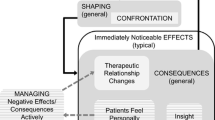Conclusion
It is important to keep in mind that confrontation with psychotic inpatients, with alcoholics, with couples, with marathon or sensitivity training groups or with patients in private practice has different as well as similar indications and may produce different as well as similar reactions and long-term results.
I must state unequivocally my belief that confrontation alone is not enough to bring about the kind of characterological change and growth which is the usual goal of psychoanalytically-oriented psychotherapy. Almost any confrontation can be accepted and assimilated to some degree if a patient is prepared for the work of psychotherapy, is in a state of positive transference to his therapist or group and there is enough mutuality, caring, regard, trust and intimacy present.
There is a sense of unanimity amongst workers who utilize video confrontation that through this experience insight can be heightened; multilevel and multichannel communications can be clarified; people can learn more of what is unknown about themselves but which is known to others; attitudes, roles and behavioral patterns can often be modified by increasing the variety and depth of information patients can obtain about themselves in relationship with their environment; and self-images and concepts can be clarified and frequently altered as individuals move toward a clearer sense of their own identity.
The development of video facilities for immediate and later confrontations with one's own self-image alone or in interaction with others is a milestone in the evolution of psychotherapy. A new depth of exploration and self-knowledge has become available to help us expand our intrapsychic and interpersonal frontiers.
Similar content being viewed by others
References
Horney, K.: Neurosis and Human Growth: The Struggle Toward Self-Realization. New York: W. W. Norton, 1950.
Erikson, E.: The Problem of Ego Identity. New York: W. W. Norton, 1958.
Goffman, E.: Stigma: Notes on the Management of Spoiled Identity. Englewood Cliffs, New Jersey: Prentice-Hall Spectrum Books, 1963.
Laing, R.: The Divided Self. London: Tavistock Publications, Ltd., 1960.
Freud, S.: New Introductory Lectures on Psychoanalysis. New York: W. W. Norton, 1933.
Buber, M.: Between Man and Man. New York: Macmillan, 1968.
Sullivan, H.: The Interpersonal Theory of Psychiatry. New York: W. W. Norton, 1953.
Schilder, P.: The Image and Appearance of the Human Body. New York: Int'l. Univ. Press, 1950.
Allport, G.: Becoming. New Haven, Conn.: Yale Univ. Press, 1955.
James, W.: Psychology: The Briefer Course. New York: Henry Holt & Co., 1910.
Tillich, P.: The Courage To Be. New Haven, Conn.: Yale Univ. Press, 1952.
Garner, H.: A Review of Confrontation in Psychotherapy From Hypnosis To The Problem Solving Technique. In: Videotape Techniques in Psychiatric Training and Treatment, Berger, M. (ed.), New York: Brunner/Mazel, Inc., 1970.
Mesmer: General Introduction to Magnetism. Carlsruhe, Germany: 1815.
Ferenczi, S.: Further Contributions to the Theory and Technique of Psychoanalysis. London: Hogarth Press, 1952.
Reich, W.: Character Analysis. New York: Noonday Press, 1949.
Alexander, F. and French, T.: Psychoanalytic Therapy: Principles and Application. New York: Ronald Press, 1946.
Rosen, J.: Direct Analysis: Selected Papers. New York: Grune & Straton, 1953.
Frankl, B.: From Death Camp to Existentialism. Boston: Beacon Press, 1959.
Wolpe, J.: Reciprocal Inhibition as the Main Basis of Psychotherapeutic Effect. Arch. Neur. Psychiat., 72:205–226, 1954.
Kubie, L.: Problems and Techniques of Psychoanalytic Validation and Progress. In Pampian-Mindlen, E. (Ed.): Psychoanalysis as Science. Second Edition. New York: Basic Books, 1956, p. 175.
Kubie, L.: Some Aspects of the Significance to Psychoanalysis of the Exposure of a Patient to the Televised Audiovisual Reproduction of his Activities. J. Nerv. Ment. Dis., 148:301–309, 1969.
Cornelison, F. and Arsenian, J.: A Study of the Responses of Psychotic Patients to Photographic Self-Image Experience. Psychiat. Quart., 34:1–8, 1960.
Geertsma, R. and Reivich, R.: Repetitive Self-Observation by Videotape Playback. J. Ment. Nerv. Dis. 141 (1965), 29–41.
Reivich, R. and Geertsma, R.: Experiences with Videotape Self-Observation by Psychiatric In-patients. J. of Kansas Medical Soc., LXIX (1968), 39–44.
Horney, K.: Alienation from Self, Chapter 6, pp. 155–175. in Neurosis and Human Growth, New York: W. W. Norton, 1950.
Berger, M., Sherman, B., Spalding, J. and Westlake, R.: The Use of Videotape with Psychotherapy Groups in a Community Mental Health Service Program. Int. J. of Group Psychotherapy, XVIII (1968), 504–15.
Sarbin, T.: Role X Theory. In Lindzey, G.: Handbook of Social Psychology. Cambridge, Mass.: Addison-Wesley, 1954.
Paredes, A. and Cornelison, F.: Development of an Audiovisual Technique in the Rehabilitation of Alcoholics. Unpublished manuscript based in part on paper presented at the 19th Clinical Meeting of the A.M.A. In Philadelphia, Pa., Nov., 1965.
La Barre, W.: Paralinguistics, Kinesics, and Cultural Anthropology (pp 191–220). In-Sebeok, T., Hayes, A., and Bateson, M., (Eds.): Approaches to Semiotics, London: Mouton, 1964.
Cameron, D.: Psychic Driving. Am. J. Psychiat., 112:502–509, 1956.
Author information
Authors and Affiliations
Additional information
Milton M. Berger, M.D., is Assistant Clinical Professor of Psychiatry, College of Physicians and Surgeons, Columbia University; Faculty, American Institute for Psychoanalysis.
This is a revised version of Chapter 2 entitled, “Confrontation Through Videotape” inVideotape Techniques in Psychiatric Training and Treatment, Berger, M.M. (Ed.) New York: Brunner/Mazel, 1970.
Rights and permissions
About this article
Cite this article
Berger, M.M. Self-confrontation through video. Am J Psychoanal 31, 48–58 (1971). https://doi.org/10.1007/BF01872309
Issue Date:
DOI: https://doi.org/10.1007/BF01872309




